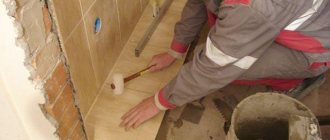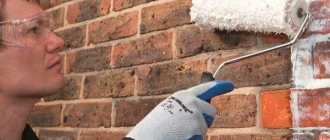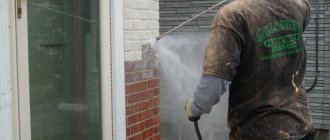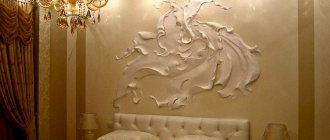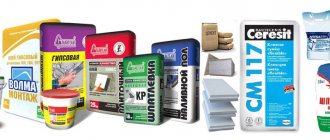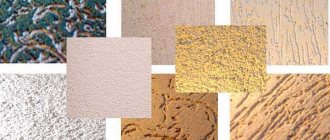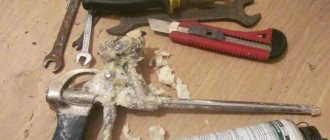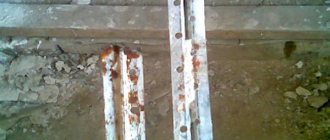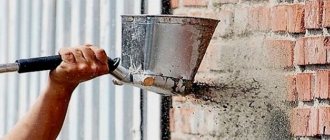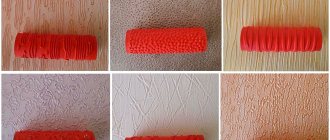How to clean brick from plaster.
The look of a brick wall in your home or office space will add character to each room, making it more beautiful. Old-built houses in most cases have walls that are made of solid red brick, which were then plastered. In order to give the walls an initial look, we need to dismantle the old plaster. Removing old plaster is not that difficult.
In this publication, we will look at how to remove plaster and give a brick wall a sophisticated look.
1. You need to check the wall where you want to dismantle the old plaster by making a small hole in it, reaching the brickwork. It is necessary to check the brick for its hardness. If the brick is outdated and crumbles with a slight impact, then you need to abandon this idea, since after the plaster is dismantled, the wall will look very bad.
2. Having checked the brickwork for its suitability, prepare the room for its repair. Remove all furniture in the room, cover the windows and floor with polyethylene film, as there will be a lot of dust and dirt. Also tightly close the doors that connect adjacent rooms to limit the penetration of dust into the adjacent room. Cover the windows so that you can access them to ventilate the room.
3. Use a chisel or chisel, and also a hammer, to dismantle the old plaster. Hold the chisel at an angle in order to cut down the plaster layer. Remove old plaster as soon as a lot of it has accumulated.
4. After removing the old plaster, you need to take an iron brush, with it you will get rid of the remaining particles of plaster. Start cleaning with a brush from the top of the wall, so that the remaining dust does not contaminate the already cleaned wall.
5. You need to take a bucket of warm water. Using a clean cloth, start at the top of the wall to remove any dust from the brick. Change the water occasionally so that the wall remains clean after washing it. If your room has floors made of wood, laminate parquet, etc., then you need to monitor the water that flows along the walls and, if possible, remove it from the floor.
6. As soon as the wall has dried, you need to apply “Wet Stone” varnish to it - this will add an elegant look to the wall.
7. Let the varnish dry. If the varnish is strongly absorbed into the wall and does not give the proper shine, then apply another layer.
Warning.
1. When removing plaster, wear protective clothing, goggles and a respiratory mask.
2. There may be electrical wires under old plaster. Before dismantling the plaster, turn off the power to the room.
Note.
To dismantle old plaster, you can use an electric chisel, but it does not guarantee that during this process the brick remains smooth and not chipped.
Publications similar to How to clean brick from plaster:
- How to make Venetian plaster Would you like to find out how to create polished Venetian plaster walls? You can do this with.
- How to glue wallpaper to a wooden surface. Are you bored with the wood paneling that covers your walls and want some innovation in your own.
- Wall insulation in the middle of the room. Since the quality of construction of apartments is not satisfactory during the construction of high-rise buildings.
- Installation of tiles on top of old ones. Sometimes it happens that after some time, we become bothered by a coating that is already outdated.
- How to check the load-bearing capacity of old plaster? How to check the load-bearing capacity of old plaster.
Comments on the publication “ How to clean brick from plaster. “:
When copying the publication “How to clean brick from plaster.” A link to ru-stroyka.com is required!
How do you know how durable plaster is?
Removing plaster from wall surfaces begins with deciding on a fragmentary or complete change of coating. The entire area of the room is examined and it is found out how firmly it is fixed to the brick wall. To do this, check the plaster layer using a spatula or scraper blade. If the decorative plaster is destroyed in one or two places, then the weakened areas are beaten off or covered with a composition that includes fine-grained sand.
If lime or cement mortar falls away when the trellises are removed, then it is not possible to reconstruct this covering. The finishing layer should be beaten off without any residue and a fresh one should be applied. To check the stability of plastered slopes, ceilings and brick walls, an acoustic method is used - tapping the surfaces with the handle of a hammer. In areas where the coating has moved away from the base, a dull, unclear sound is heard.
If traces of mold are visible in the room, it is important to remove the contaminated coating not only in these areas, but also to cover the surrounding areas by about half a meter along the contour. Mold and grease stains are eliminated by excision and washing with special means. The resulting depression is covered with new plaster.
Any cracks and chips in the ceiling or wall coverings are widened into a wedge-like shape, moistened with water, plastered and washed. Plaster is applied in several stages. A solution of 1/3 of the groove volume is applied to the brick. After drying, fill 2/3 full. Allow to dry again, and at the end the flaw is completely covered.
Do I need to remove old, durable plaster?
The need to completely clean the wall depends on the specific situation. Some compounds are easier to remove, others are harder. Moreover, removing old plasters is not always reasonable. But in other cases it is hardly possible to do without it.
The demand for wall cleaning depends on the composition of the plaster:
- Clay. They are often used for cladding fireplaces and heating panels. Destruction and peeling of the clay cladding leads to the need to replace it, since the heat conductivity decreases.
Cleaning is also inevitable when tiling the stove, which requires a denser base.
- Limestone. It is removed when the layer weakens, and also if it is necessary to apply sand-cement plaster.
- Plaster. Plaster dismantling is carried out as it is destroyed.
- Cement. Often removed due to design errors made by previous builders (violation of the requirements for sand-cement plasters).
- Polymer. Most polymer plasters are durable. Any solution can be applied to them. Due to this, the removal of artificial masses is associated with errors made during their application, leading to peeling and cracking.
The correct removal of plasters must be justified. Plaster is not wallpaper; it is not recommended to change it without a good reason.
Old coatings can be removed completely or partially. This depends on the condition of the layer and the composition of the upcoming new coating:
- Repair. The cladding requires partial repair. It is better to remove weak, loose, exfoliated parts. If the area of plaster that has retained its strength is small, the wall should be cleaned completely. However, if the damage is not significant, you can leave the wall untouched, cleaning only the problem areas.
- Replacement. The new solution can adhere very firmly to the old (but strong) one. This depends on the hardness of the previous coating and the composition of the fresh one.
The new plaster should not be stronger than the previous one, so that, by shrinking, it does not destroy the old weak cladding, which has less tension.
So, any other solution can be laid on sand-cement plaster (if it is not loosened). Cement cannot be applied to gypsum, since the latter will destroy the surface of the previous one, the adhesion will be insufficient and short-lived. Limestone is reliable as a base for gypsum and clay. But you can’t apply anything at all (besides clay) to clay plaster - it won’t stick. But the clay-sand mixture itself is applied to any base.
How to remove old plaster from walls.
Before dismantling, the wall is carefully examined to determine the condition of the cladding. If there are no plans to replace the coating, then it is enough to remove only the poorly adhering parts and areas around the cracks.
To find out the reliability of the connection of the coating with the plane of the wall, it is tapped with a blunt iron object (hammer, pick). In places where there is a good fit, the sound of impacts is louder.
Any movement of the layer under pressure from the tool is a sign of insufficient adhesion to the Base. Such parts are exposed first.
How to remove old plaster from walls manually.
It is good to use a steel spatula, which is used to pry up the falling pieces and cut them off. Strong parts are knocked down with a pick, ax or chisel.
A single rule for a variety of types of plasters: before dismantling, the cladding must be thoroughly wetted. This will make it possible to soften it and significantly reduce the amount of dust.
The gypsum board, which is located under the plaster, can be easily damaged. Thanks to this, large impacts are eliminated; it is better to work with a scraper - a tool similar to a well-honed spatula.
First of all, they violate the integrity of the coating in weak areas, clearing a small fragment in order to gain access to the end of the layer. Then, having driven a scraper under it, you should remove the plaster.
If it is held firmly and does not give in, you can use a chisel or chisel, tapping it with a hammer.
It is best to hold the chisel at an acute angle so as not to destroy the plasterboard.
What electric tool is suitable for the job?
Reliable compositions cannot be knocked down or removed with a hammer. It’s easier to pick up a hammer drill - an electric drill with a slotting mode. True, with such an approach there is a high level of noise and dust, which is not always acceptable.
Using an angle grinder with a disc prepared for working with the appropriate material, the plaster is cut into small squares, which are then knocked down with a chisel or hammer drill.
It is more convenient to remove very small pieces of mortar using a grinding machine with a coarse-grained “sandpaper belt.” It is best to use equipment with dust extraction capabilities. For example, using a vacuum cleaner.
First, weak areas are removed along the entire wall, working with a pick or chisel. Only then do they begin automated work.
When do you need to clean walls from old plaster?
There is also a direct connection between the composition of the plaster and the relevance of cleaning:
- Polymer. Under any conditions, the strength of materials of this group is increased. They are suitable for further application of any solutions. Most often, deletion occurs if mistakes were initially made;
- Cement. Dismantling is also associated with eliminating mistakes made by builders at the previous stage. An example is when the requirements for the compositions themselves are violated;
- Types of old plaster on gypsum. Here everything is determined by the degree of destruction;
- Limestone. A weakened layer requires removal, the same is true when it is necessary to use cement-sand mortars.
Unless there are serious reasons, replacing plasters is not recommended. Weak, loose and delaminated elements are removed in any case. The wall can be completely processed if the old materials occupy a small area. Bonding old and new finishing methods doesn't have to be a hassle. The question of how to remove plaster from brick walls deserves special consideration.
Decorative plaster, depending on its relief and performance characteristics, has a certain service life. Therefore, after some time it will be necessary to eliminate its remnants. There are several ways to remove the finish.
Dust-free methods
The surface must be well moistened with warm water from a spray bottle or a wet sponge. The swollen layer of plaster (putty) can be easily removed with a metal spatula or scraper. During operation, the wall must be periodically wetted.
A less common method of removing the outer layer of decorative plaster is mechanized cleaning of surfaces with high-pressure water jets. Disadvantages of this option:
- a large amount of moisture forms on the floor, which can cause water to leak to the neighbors below;
- purchasing expensive equipment is beneficial only for professional builders.
How to clean a brick wall
First, the plaster is removed from areas where it no longer holds. This can be easily checked by tapping all areas with a hammer. A dull sound means one thing - the facing material has already peeled off. Loud blows mean a strong grip of the old composition.
The plaster is cleaned down to the brickwork. After removing easily peeling sections of the old coating, further processing is carried out along the brickwork. Place a chisel or chisel between the plaster layer and the brick wall. Then, gently knock the loose pieces onto the floor with gentle blows of the hammer.
If durable material cannot be removed with hand tools, it is advisable to use a hammer drill with a blade-shaped attachment in the “chipping” mode. Another way to remove durable coating is to divide the wall surface into fragments using furrows. To do this, use a grinder with a disc for processing stone. Then the separated parts of the finishing material are knocked out with a chisel or perforator. The brickwork, freed from plaster, must be primed and allowed to dry for at least a day.
How to quickly remove from concrete
The layer of old coating on the concrete wall is removed with a narrow or medium spatula.
We also recommend using a special scraper, the metal edge of which must be well sharpened. To speed up the work of cleaning walls, we recommend using a sander. A grinding wheel with coarse sandpaper or a diamond bowl is used as an attachment. The disadvantage of this method is that too much dust is generated during surface treatment. You can reduce its amount using a construction vacuum cleaner.
Recommendation - when working with power tools, use gloves, a respirator, goggles, ear muffs and protective clothing. This will protect you from injury.
How to remove old plaster from a wooden wall
Wooden walls in old houses were previously plastered using reinforcing structures - shingles, metal mesh, and other available materials. When removing the old layer, use a chisel and a hammer to knock off the flaking pieces of plaster without touching the retaining structure.
If during the repair it is planned to replace the reinforcing structure, a wide vertical groove is prepared in the middle of the wall, cleared to the wooden surface. Then the retaining mesh is dismantled along with the plaster.
Savings associated with the dismantling of outdated finishes.
The cost of repairing the premises can be reduced if only exfoliated layers are removed. It is recommended to leave what is held securely enough. This will allow the leveling to be carried out using a smaller amount of solution.
It is correct, for example, to purchase a more expensive mixture, but lay it thinly. And “gain” the main thickness with the same composition with which the wall was covered before. The cost of such repairs is minimal, although cladding is used with a higher cost per m2.
If a situation arises in which it is best to choose the work of professional finishers, then preparing the surface for work yourself can be a source of savings. After all, dismantling the plaster will increase the fee per sq. m. m. since the team will have to do more work.
This makes no sense - preparing walls does not require any special knowledge or skill. It is more economical to pay only what professionals charge per square meter. professional work.
Where to dispose of waste from dismantling.
The problem of recycling the remains of outdated finishing is quite acute. It is not always possible and time to remove it, which is due to the distance from city landfills and the work of operational services.
In apartment buildings, only removal is possible. You can divide construction waste into bags and put it in a container if utility companies do not prohibit this. The weight of cement plaster per 1 m2 that appears during dismantling can be calculated by knowing its approximate thickness.
For example: the weight of 1 cubic meter of screed is 1000-1500 kg, which means the weight of 1 square meter. 1 cm thick – 10-15 kg. The average thickness of plasters is 1.5-2cm. This means that 15-25 kg of waste will come out per meter of wall.
In private houses, it is easier to cope with the problem: waste can be used.
- Concrete screed. Used for filling paths, filler in concrete solutions for pouring sidewalks and platforms.
- Clay plaster can be stored on site for reuse. In this case, there will be no need to mix the solution, since the proportional ratio of sand and clay has already been established, the materials are thoroughly mixed. You just need to soak them.
- The remains of the gypsum-based plaster mixture are used as a bulk heat insulator during the construction of floors of outbuildings.
- Lime plasters are good fillers for soil that is not ideal for trees to grow on.
Before removing textured plaster from the walls, it is best to prepare a place for storing waste.
It is better to store the remains of the plaster under the overhang of the roof until it is sold. Otherwise, if they get caught in the rain, they will get wet. This will increase their weight, making loading onto a garbage truck a little more difficult.
Clay waste generally combines into a single monolith if it is stored in bulk.
What is the most convenient way to load waste into bags?
Since it is very easy to remove plaster from a wall, the room quickly becomes overgrown with dirty, dusty waste. Now they need to be taken out.
Small loose construction debris is easier to store in bags. To make it easier to load it, you need to use a bucket without a bottom. A bag is placed on the bottom and the bucket is placed on the floor. Loading is done with a scoop or shovel.
When the bucket is full, it is lifted so that the contents fall into the bag.
Also read:
Plastering aerated concrete walls in the middle of the room and on the outside
Plaster or gypsum board, which is better to choose?
Plaster for external work on concrete: photo and video
Repairing cracks in plaster and why it cracks
Plaster for work carried out outside: types, proportions and compositions
Comment Cancel reply
From cement mortar
After construction work, dried cement mortar most often remains on the brickwork. To remove it, it is worth considering the degree of contamination and the material of the brick. Comprehensive information on bricklaying can be found here.
The first method of cleaning is mechanical. First you need to acquire the following tools for work:
Large pieces of cement can be removed using a chisel and hammer. Blots of average sizes are removed with a spatula.
When mechanically cleaning, blows should be applied along the surface of the brick. This will prevent scratches on the material.
When the surface is cleaned, the final step is sanding. To make the process easier, you can take a block of wood and attach sandpaper to its working side. Then such bars need to be processed into bricks along their surface.
The second option for cleaning brick from cement is considered chemical. For this you will need:
- A substance based on phosphoric or hydrochloric acid.
- Brush.
- Putty knife.
- Iron brush.
Apply the prepared solvent with a brush to the areas that need to be cleaned. After this, you need to wait for some time (approximately 30 minutes). After which you can clean off the cement with a spatula, then clean it with a brush.
The chemical option for cleaning brick is suitable for red porous ceramic stone. White silicate brick will not withstand such cleaning - it will simply crumble.
When chemically cleaning bricks, you must strictly adhere to the instructions indicated on the solvent packaging. To get a good result, you can clean a small section of the wall, and then carry out a full cleaning.
You can learn more about the chemical cleaning of bricks in the video. Advice and instructions for performing the work are provided.
Technology and methods of cleaning walls depending on the coating
The choice of method for cleaning a brick wall depends on the type of coating. When deciding how to clean a brick from mortar, the degree of contamination, the area of the surface to be treated and the required level of efficiency in completing the work are also taken into account. If you urgently need to improve the aesthetics of masonry with complex formations in the form of fossilized mortar, you should give preference to chemical cleaners. In other situations, priority is given to environmentally friendly methods and technologies, which are selected depending on the nature of the coating.
How to clean brick from cement
Cleaning a brick wall from a cement coating involves the following stages of work:
- Softening the solution by applying water. This will make the composition more pliable and move away from the base material more easily. It is recommended to water the coating generously until the liquid stops being absorbed.
- Removing excess cement mixture mechanically. When deciding how to clean a brick from old mortar, they use tools depending on the nature of the contamination. Flat cement stains can be easily removed with a trowel, spatula or stiff brush. Fragments of the solution are first pryed off with a spatula, then the remains are cleaned off with a brush. Large cement pieces will have to be knocked down using a chisel and hammer. They work carefully so as not to damage the brick: you cannot apply perpendicular blows, they must be directed up or down in relation to the wall.
- Grinding. After the main part of the coating has been removed, the wall should be treated with sandpaper.
The final stage is a generous wash of the base, removing all excess.
The cleaning solution is applied to the entire area where efflorescence has formed.
From white plaque
Some types of salt deposits are easy to clean and can be easily washed off the wall with water from a hose. At the same time, to eliminate a separate category of efflorescence, you will have to look for more radical measures, including treating the brickwork with chemical cleaners and a metal brush. Ready-made cleansers are divided into different types, which are designed to destroy certain types of salts. Experimentally or on the recommendation of the seller, you can select the desired solvent option.
After choosing a chemical with active substances and aggressive acids to eliminate white deposits on brickwork, you need to ensure that you have personal protective equipment. They begin work exclusively in protective clothing, armed with a respirator, goggles, and rubber gloves. The tools you will need are a roller and a stiff brush.
Stages of work:
- Dilute the cleaning product with water according to the instructions on the package.
- Apply the solution to the entire area where efflorescence has formed. Leave the product on the wall for the period of time specified in the manufacturer's instructions.
- After time has passed, the solution is washed off the surface with water using a brush.
When removing white deposits using a solution of hydrochloric acid, the brick base is first well moistened with water, only then an aggressive composition is applied with a roller. After 10 minutes, you can rinse the wall with water pressure from a hose. After the masonry has completely dried, treat the area with a water repellent. Such prevention guarantees 10-year protection of walls from salt intrusion.
After cleaning the brick and completely drying the masonry, the surface of the wall is treated with a water repellent.
From clay
Dried stains and excess fragments of the clay mixture are easily washed off with plain water. To do this, it is enough to soften the coating by applying liquid to the selected area. After a few minutes, wash the brick wall under water pressure from a hose. Large pieces of clay are removed using a spatula or knocked out with a hammer and chisel. The remains of the clay mixture are removed with a brush and washed off.
If you need to get rid of oil, tar or bitumen stains that remained on the masonry after construction, use white spirit, kerosene or turpentine. To eliminate unsightly formations, you need to wipe the area with a rag soaked in the chosen product.
From plaster on brickwork
To remove plaster, you can use several methods:
- Apply water to the coating using a spray bottle, evenly wetting the material; after a few minutes, remove the cement-sand mixture with a spatula or trowel;
- moisten the coating generously, then wash off the plaster from the wall under water pressure from a hose;
- Use a wire brush to manually remove any remaining plaster mixture.
They also effectively clean masonry from plaster using an electric drill with a special attachment.
From soot
Soot stains are removed with a detergent solution using a brush. To destroy old formations, it is worth using a liquid with an organic solvent.
From paint
Paint stains are removed using a solvent with a suitable composition. Work stages include:
- softening the paint by applying a solvent;
- scraping the coating from the base material using a spatula or scraper.
Next, this area should be washed with warm water and detergent.
From white plaque
The white coating that appears on brickwork is formed due to the penetration of salts in the solution onto the surface. Very often this problem appears after heavy rainfall and brings many problems.
Salt has a bad effect not only on the appearance of the walls, but also on the strength of the material. It destroys the layer on top of the brick, which leads to cracks and chips. Due to this, it is necessary to get rid of this problem in a timely manner.
You need to purchase a specialized cleaner extract from a store that sells building materials and tools. Then dilute with water in a ratio of 1:10. After:
- Apply the solution to the wall with a brush.
- Leave for 20 minutes.
- Rinse with water. To do this, use a clean rag.
Acids and various surfactants contained in compositions for removing white plaque react with salts, making them easy to remove. To consolidate the result, the wall surface should be coated with water-repellent agents so that by next year it will not be necessary to remove the plaque again.
How to remove clay from brick
When constructing stove fireplaces, clay mortar is used instead of cement. This prevents cracking of the material during operation. When laying bricks, it is best to immediately clean the brick from the clay mixture. To do this, use a dry cloth.
If the clay still remains on the surface, then use the method for removing cement mortar from the brickwork.
First of all, visible large pieces of clay are removed with a spatula, and then very small particles are cleaned with sandpaper.
Features of removing different types of mixtures from walls
You have to study the basic material first and then see how it holds up. The first stages always include the use of hand tools, then move on to mechanical ones, if necessary, with the help of which removal is faster.
You have to study the basic material first and then see how it holds up.
Cement plaster
It causes some problems, especially with increased strength. Cutting into circles of 50 by 50 cm is best done with a grinder. A mixture of cement and sand in the form of an array is completely cut through in such situations. Everything else can be knocked down with a chisel without any problems. Sandy coatings are removed by scraping.
It causes some problems, especially with increased strength.
Gypsum plaster
Its removal is much less difficult than the others. Here it is recommended to pre-soak the coating before continuing work. If you add vinegar, the result will be better. Lime materials are subject to the same rules as Khrushchev.
It is recommended to pre-soak the coating before continuing work.
From grout on brick
It is best to remove grout immediately from the surface of the brick. If a day has passed since application, you can lightly wet the contaminated areas with water, wait 20 minutes, then clean with a spatula.
If much more time has passed, then you need to proceed according to the following scheme:
- Purchase a specialized solution at the store and dilute it according to the instructions.
- Apply to surface.
- Wait for a specific time.
- Clean off with a spatula.
It is necessary to act carefully and not to leave the product on for longer than the prescribed time. Before starting work, it is best to seal the seams with thin masking tape so that no chemicals get into them.
Necessary tools, tools and devices
Depending on the chosen method of removing mortar or other compounds on the masonry, it is necessary to prepare the appropriate arsenal of tools and devices.
Tools that will be needed for mechanical cleaning of a red brick wall from solid contaminants:
- construction spatula or trowel;
- chisel or chisel complete with hammer;
- metal brush;
- block with sandpaper.
You should also provide:
- water to pre-wet the dried composition on the stone. It can be applied to the surface using a brush, roller or sponge. Some people prefer to use water from a hose;
- individual protection means. They begin work armed with a respirator and safety glasses. It is also necessary to prepare gloves and appropriate clothing.
When performing activities involving the use of chemicals, work exclusively in a respirator, rubber gloves and safety glasses.
Tools and accessories for cleaning sand-lime bricks:
- electric drill with a set of attachments;
- metal brush;
- sandpaper.
When working with silicate building materials, you will also need water to wet the solid compounds, so it is much easier to remove them from the surface of the masonry.
What products and tools will be needed when chemically cleaning the surface of brickwork:
- solvent. You can buy a ready-made cleaner with an aggressive composition at a hardware store or prepare the product yourself according to the manufacturer’s instructions. Most often, a solution of hydrochloric or sulfuric acid is used, diluted with water 1:10;
- roller, brush or brush for applying a chemical composition to the surface to be cleaned;
- running water to wash off the cleaner along with particles of dissolved cement;
- a metal brush for cleaning the base from small residues of dirt;
- spatula, trowel, chisel and chisel for removing massive pieces of construction mixture that have softened under the influence of the chemical composition.
When carrying out activities using chemicals, work exclusively in a respirator, rubber gloves and safety glasses, otherwise toxic substances can harm the body.
From plaster to brick laying
Very often, brickwork is completely plastered. Over time, this type of finish loses its original appearance and it is necessary to immediately refresh the walls in the room. An excellent option is to remove the old plaster layer and renew the brickwork. This option will perfectly update the interior.
To properly remove plaster you must:
- Remove all furniture from the premises.
- Close all cracks tightly to prevent dust from entering other rooms.
- Prepare a hammer, chisel, brush.
- Remove the plaster layer.
- Clean the wall from dust.
- Cover the surface with varnish.
Use a chisel and hammer to remove the plaster layer. You need to start from the top corner and gradually move down. The tool must be held at an angle.
During the working period, the plaster must be regularly removed from the room so that it does not accumulate underfoot and interfere with work. After upholstery, use a brush to remove all very small particles and dust from the wall.
Then you need to wash the brick. Using a wet cloth, you need to clean the surfaces of the walls, starting from the top corner. To give brickwork an attractive appearance, use a specialized varnish.
How to clean soot from cement
During the operation of a building with brickwork, soot may appear on it. It is necessary to get rid of it as soon as possible, otherwise it will be more difficult to remove soot in the future.
Before you start work you need:
- Cover the floor with film to prevent soot from settling on it.
- Take a detergent for cleaning work, as well as working tools.
- Clean the wall.
Any cleaning agent (for example, powder) is suitable as a cleaning agent. The main thing is that it foams well. A soap-based solution is diluted in a basin. After that, a sponge is dipped in soapy water and the cleaning of the brick begins.
You need to start from the top corner, then gradually go down. The surface must be slightly moistened and leave a soap scum. After a couple of minutes, this foam, along with the soot, can be easily removed using a clean cloth.
After applying a soap-based solution with saturated foam to the wall, you need to wait some time. If after a couple of minutes the foam turns black, then this product has begun to act and the solution can be washed off.
In addition to soap, you can use traditional table vinegar. To do this, it is diluted in water in a ratio of 1:1. After which the solution is applied to the wall, and after a couple of minutes the wall is cleaned with an iron brush.
There are special products for removing soot that are sold in every store that sells building materials and tools. They are much more effective and quickly remove dirt, but this option is very expensive.
If a brick wall was covered with paint, but began to peel off over a certain period of time, then it is necessary to immediately remove the paint, which is already outdated. The modern method of sandblasting walls is constantly used. However, this may damage the material.
Because of this, it is best to adhere to the following tips:
- Do the initial paint removal.
- Free from fungus.
- Perform chemical treatment.
- Do a secondary paint removal.
First you need to remove the loose layer of paint. All visible surfaces of the walls, on which peeling paint is noticeable, are finished with a spatula. Then the wall is carefully finished with a brush to remove dust.
The second stage is getting rid of the fungus. A specialized solution is prepared (bleach and water in a ratio of 3:1) and applied to the wall with a brush. After which it is thoroughly cleaned with water.
When the wall is finally dry, another solution is applied to it, which removes the remaining layer of paint chemically: caustic soda and water in a ratio of 1:3.
A little flour is added little by little to this type of solution until it becomes mushy.
The prepared solution is applied to the wall with a spatula and left for 2 days. After that, warm water from a hose (under high pressure) removes the solution from the surface simultaneously with the old paint.
If you need to clean a wall in your house, then while applying the solution to the walls, strips of paper are glued to it. It is then removed from the surface simultaneously with the paint.
Instead of a homemade solution, you can choose a specialized solution in the store. To breed it, you must follow the instructions.
Options for subsequent painting of the wall can be found in the publication How to paint a wall built of brick
Recommendations from professionals
For good brick cleaning, use the advice of professionals:
- When cleaning cement mortar, the brick can be wetted with water. The cement will absorb some moisture and come off very easily.
- The chemical option for cleaning brick from mortar is carried out exclusively for red porous ceramic stone.
- When using different chemical solutions to clean bricks, you must wear gloves and protective clothing. It is best to cover the floor with film.
- Before cleaning the brick, it is best to do a test cleaning on a small area. This will help ensure that the product will not damage the surface of the material.
It is very easy to remove plaque from brick using improvised means. To speed up the work, you can choose a solution in the store. The main thing is to follow the instructions for performing the work. Thanks to this, you can get high quality results.
Cleaning methods and technology
There are several ways to remove various types of contaminants from the surface of a brick wall:
- use of high pressure water jet;
- sandblasting cleaning method;
- a mechanical method of cleaning a brick wall using hand tools and devices;
- elimination of complex contaminants using chemicals.
In some cases, the combined use of several of these options is required to optimize work. This is especially true if you have to solve the problem of how to clean old bricks from mortar for recycling.
Features of using a high pressure water jet
Using this technology, it is easy to remove salt formations and other simple stains on the surface of a brick wall. The object is cleaned due to high pressure when supplying the substance, which is regulated in the range from 15 to 220 bar. When choosing how to clean facing bricks, you should take into account that using a pressurized water jet to ensure the aesthetic appearance of the masonry gives good results. Among the advantages of the technology, they also note a gentle effect that does not damage the surface of the material, and environmental friendliness.
